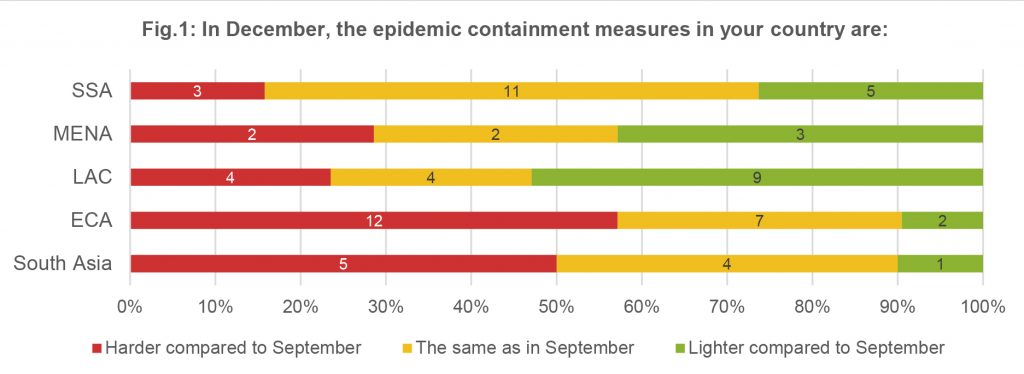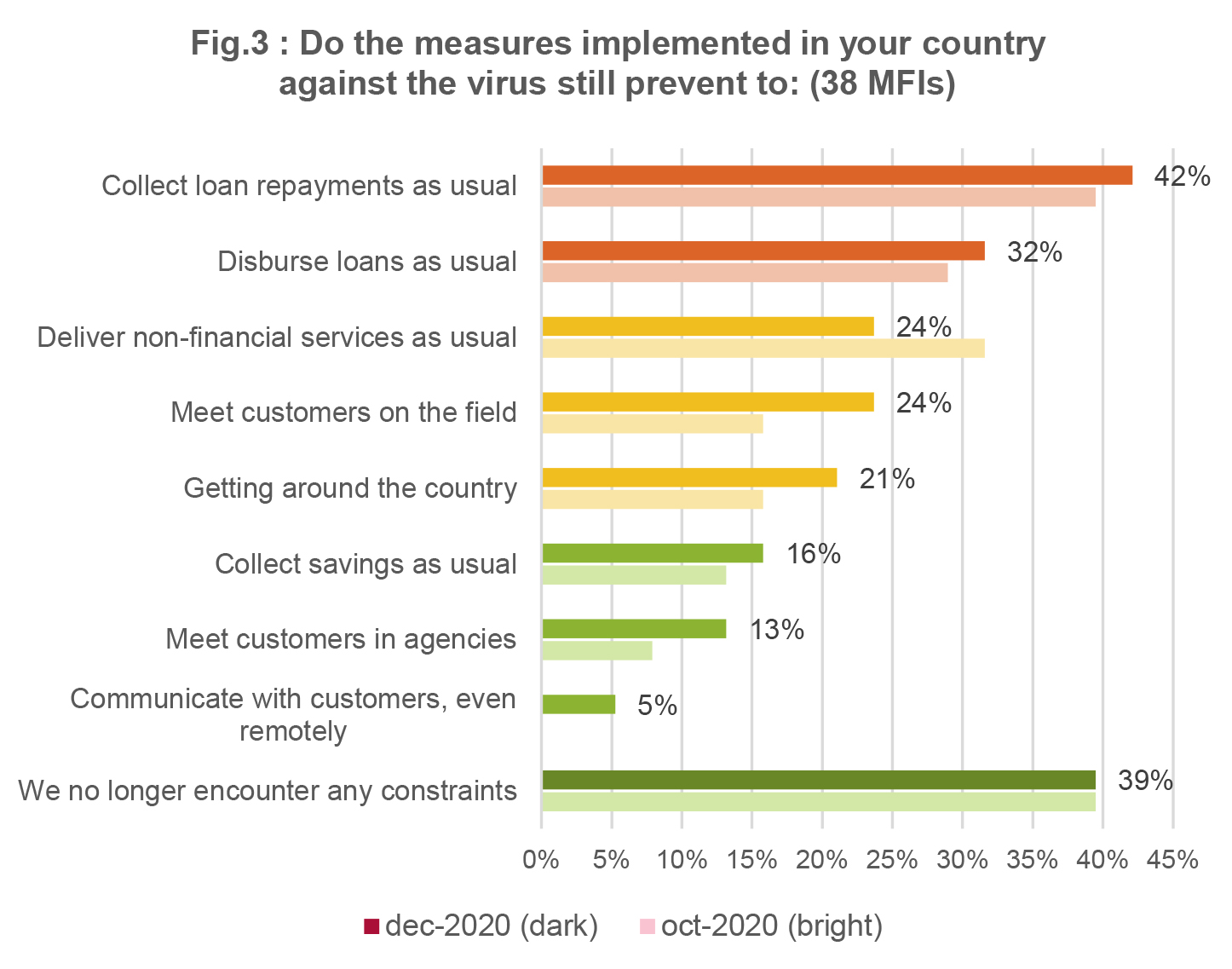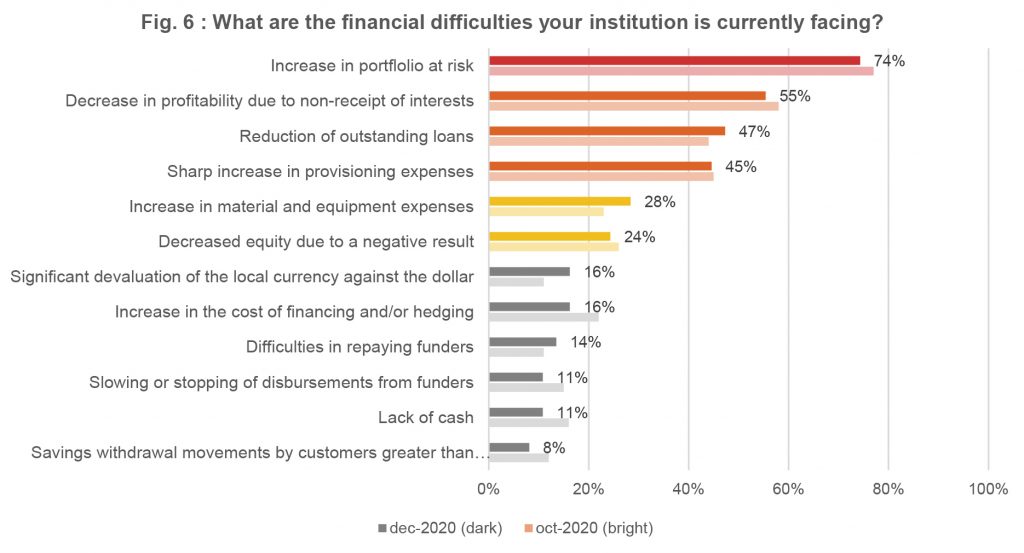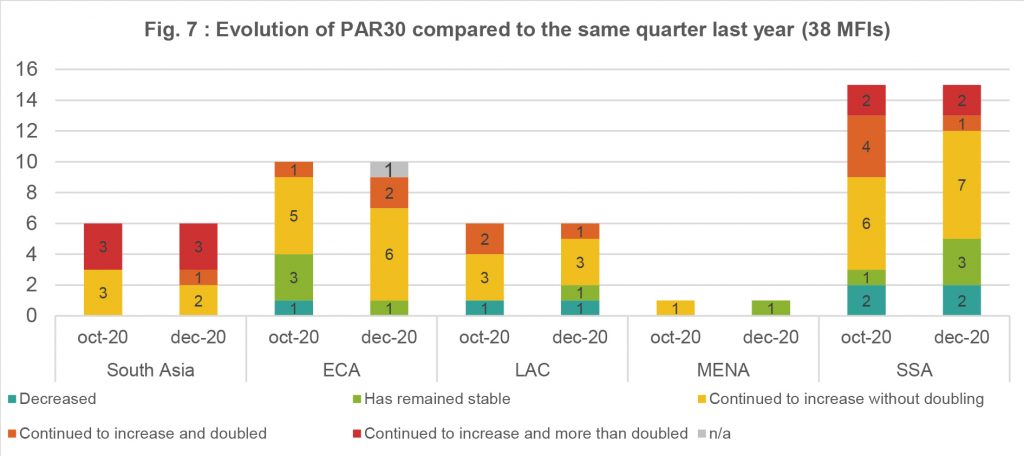The Will of Microfinance Institutions to Maintain Their Activities During Covid-19 Crisis
Source : Grameen Credit Agricole Foundation
ADA, Inpulse and the Grameen Crédit Agricole Foundation have collaborated to monitor and analyse the effects of the Covid-19 crisis for their partner microfinance institutions worldwide. This monitoring was carried out regularly throughout the year 2020 in order to have a better vision of the situation’s evolution. Through this regular and in-depth analysis, we hope to contribute, at our level, to the construction of strategies and solutions tailored to the needs of our partners, as well as to the diffusion and exchange of information between the different players in the sector.
In summary
The results reported in this article come from the fifth survey jointly (1) conducted by ADA, Inpulse and the Grameen Crédit Agricole Foundation. Responses were collected in the second half of December from 74 microfinance institutions (MFIs) located in 42 countries in Eastern Europe and Central Asia (EAC-28%), Sub-Saharan Africa (SSA-26%), Latin America and the Caribbean (LAC-23%), South Asia (14%), and the Middle East and North Africa (MENA-9%) (2).
At the same time, the major constraint that remained was the difficulty in collecting loan repayments, which implied increasing the portfolio at risk. This last point is still valid at year-end, and three quarters of respondents still report an increase in RAP. In added to this is the deterioration of the epidemiological situation in the world in the fall of 2020, as evidenced by the responses gathered in December 2020. The epidemic containment measures taken according to local contexts may once again have consequences on the activities of MFIs and their clients, and a return to normalcy is not yet on the agenda.
However, these new complications and their implications are not new. Thus, they have limited impact on MFIs’ risk indicators. The stability of the increase in PAR, as well as in recovery levels, does not reflect a further major deterioration in MFIs’ financial situation. This relative balance also corresponds to the MFIs’ state of mind as they approach 2021. Despite an unstable context and all the obstacles it entails, the vast majority of our partners expect their activity to grow in the new year, in terms of both portfolio volume and the number of clients. This confidence, which was already evident in the surveys conducted over the summer, is a further sign of the resilience of these institutions.
1. MFIs are always operating in unstable and difficult conditions.
Our last survey, conducted in October, showed a great improvement in the operating environment for MFIs and a gradual recovery in activity in all regions of the world. However, in a large number of countries, even those that appeared to be managing the virus’ spread well, new, more restrictive measures to contain the epidemic were taken in the last quarter of 2020 in response to the new increase in cases. This deterioration is particularly confirmed by our partners in Europe and Asia, where MFIs in South and Central America, Southern Africa and North Africa are reporting an improvement in the situation.
Comparing the responses of our 38 partners who participated in the October and December (3) surveys in the following paragraphs confirm the observation of a return of certain difficulties for MFIs, and are in line with the general results obtained at the end of the year.
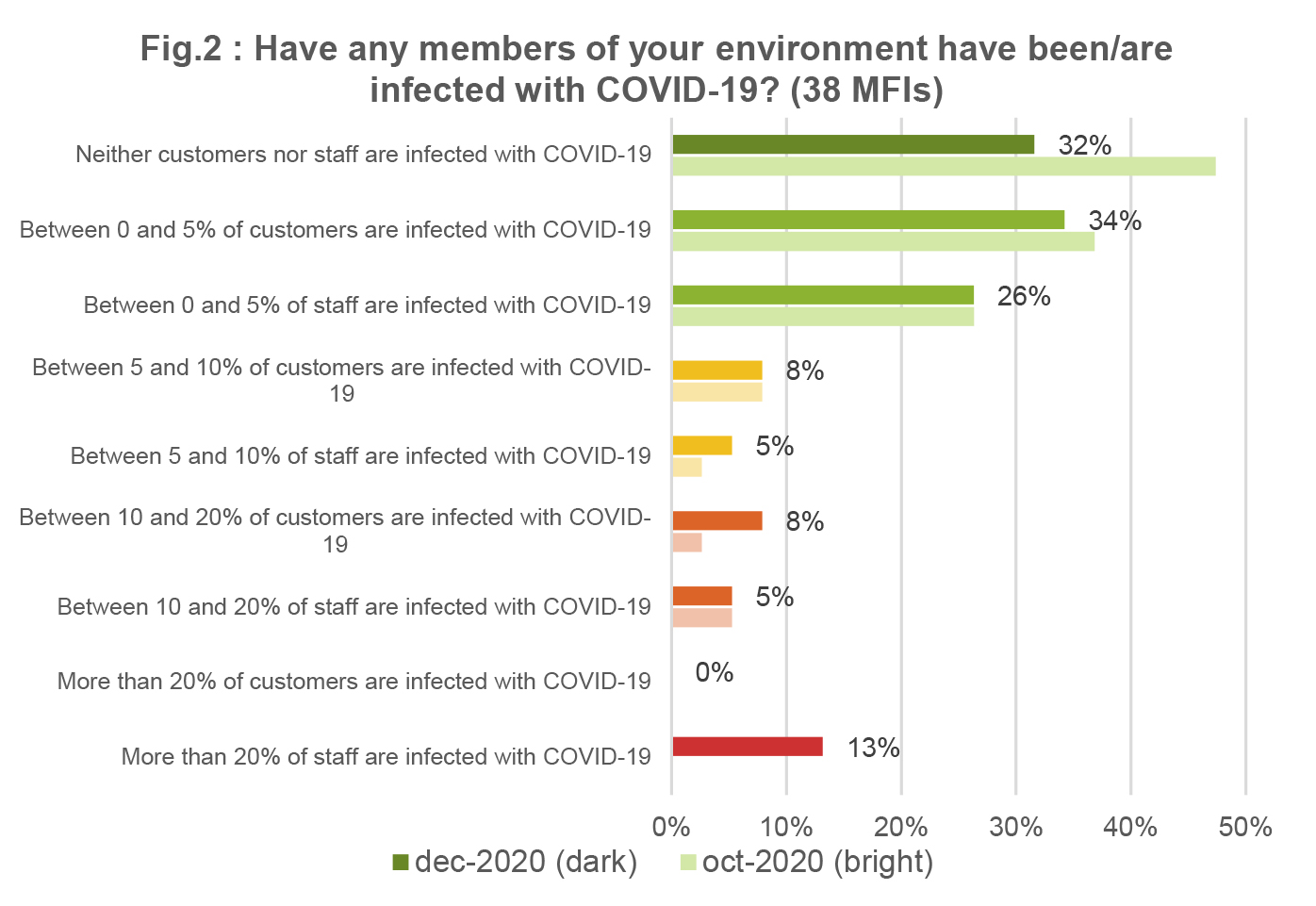
In terms of operational constraints, results are relatively stable between the two periods. The list of MFIs indicating that they no longer face operational constraints remains more or less the same (39%), and is concentrated in Central Asia and West Africa. It should be added that collecting loan repayments (42% of the sample) and disbursing new loans (32%) remain the two main difficulties encountered by MFIs.
Difficulty getting in touch with clients, both in branches and in the field, was considered a consequence of the crisis for only 16% (6 MFIs) of this sample in October, and this figure increased in December (24%, 9 MFIs). In detail, it should be noted that the location of MFIs that highlight this constraint has evolved over
the last two months. Thus, they were particularly located in Latin America and the Caribbean and East Africa in October. In December, this point was raised by MFIs in Southeast Asia (3/6), Eastern Europe (2/5) and West Africa (2/8). At the general level of the survey, 30% of the MFIs indicated that they were once again limited in their activities, despite a gradual recovery.
2. Therefore, customers remain exposed
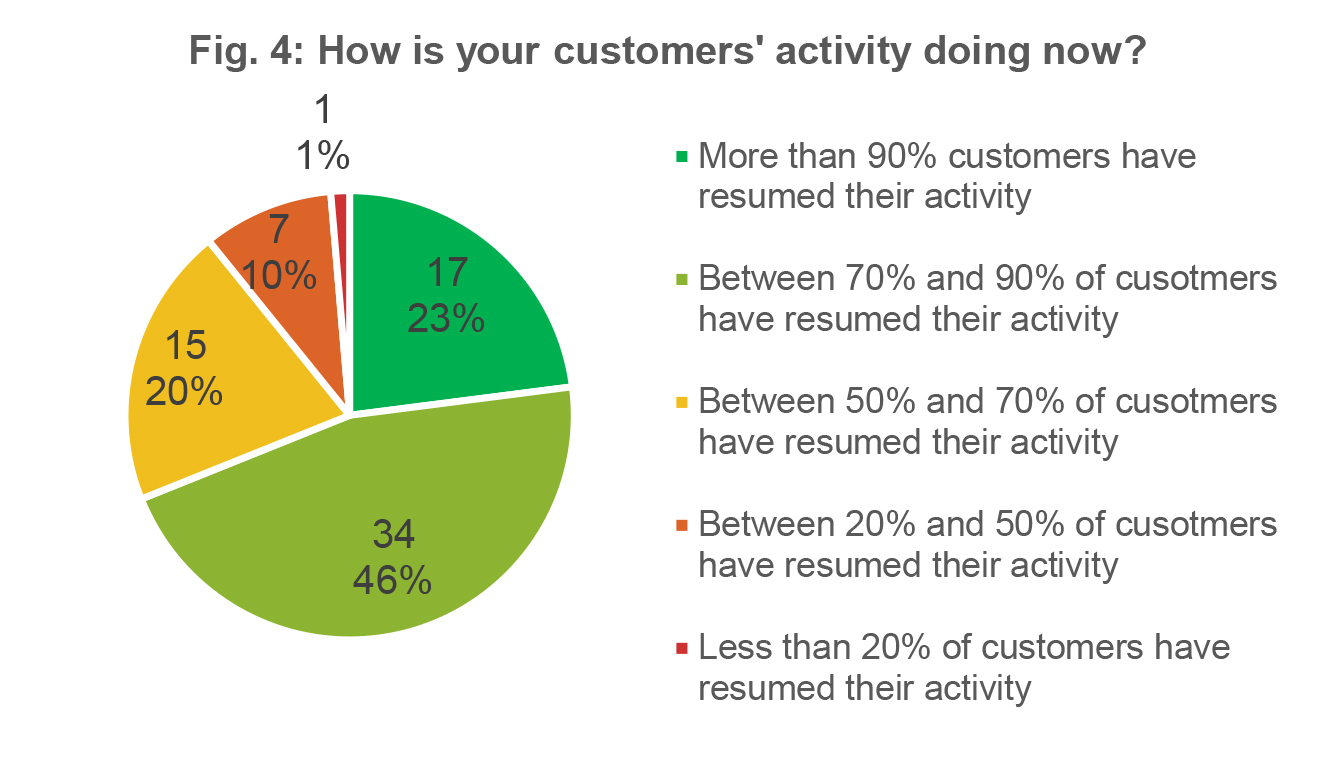
Our partners’ responses also make it possible to continue profiling the customers most affected by the crisis. First of all, it should be noted that a large proportion of the MFIs surveyed rule out the possibility that there is a category of clients that is more affected than the others, whether in terms of gender, location (urban or rural) or age. In detail, 42% (31 MFIs) of respondents believe that all of their clients are impacted identically, and 51% (38 MFIs) indicate that there is no significant difference in repayments based on 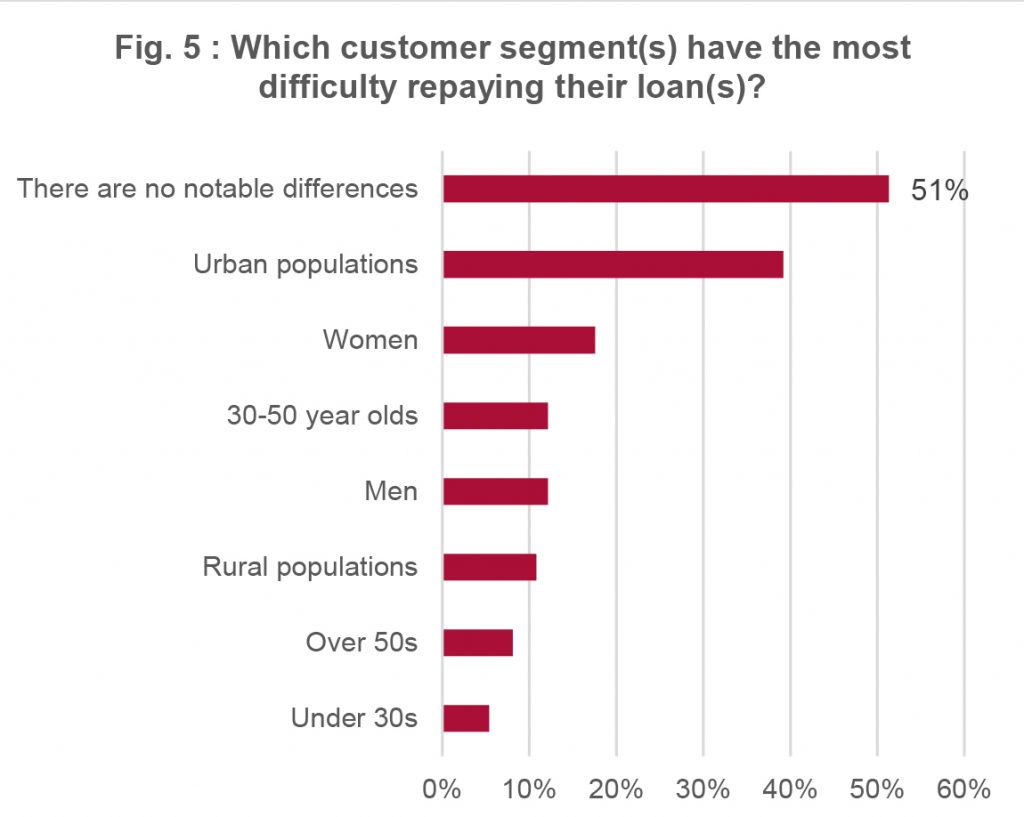
Among the MFIs that perceive a difference in the impact of the crisis on their clients (36 MFIs), one criterion stands out for the most part: 76% (27 MFIs) believe that the most impacted populations are urban populations. The same proportion claims that this difference is reflected in loan repayments. These responses confirm our previous results for the most affected sectors, which are definitely urban. The fact that the criterion of rurality is hardly mentioned goes in the same direction, and echoes the agricultural sector, revealed during the surveys by our partners as a sector less affected by the crisis linked to Covid-19 than the others, and towards which a certain number of MFIs imagined they wanted to move. Finally, a last characteristic is mentioned by MFIs reporting disparities in the impact of the crisis: 36% (13 MFIs) perceive that women are more affected than men and therefore by default may have more difficulty repaying their loans. It should be noted that a portion of the respondents serve only women clients, which logically makes them the most affected population in the sector.
3. Now well-identified challenges for MFIs
MFIs are now aware of activity levels that are still at half-mast or of the measures implemented by the local authorities to contain Covid-19. In addition, to which they are adapting. Thus, the financial difficulties mentioned by the MFIs are very stable from October to December 2020 and do not highlight any new trends. Two of the four most cited difficulties remain linked to the MFIs’ declining profitability, due to the increase in provisioning expenses (45% of the respondents, 33 MFIs) and the non-collection of interest (55%, 41 MFIs). These two points are closely linked to the most striking difficulty of the crisis for MFIs during this period: the increase in portfolio at risk (74%, 55 MFIs).
In December 2020, 74% (55 MFIs) of respondents indicated that more than 70% of clients were repaying their loans, and 37% reported client repayment levels above 90%. On the other hand, only 9% report that less than 50% of clients are able to repay their loans, which is in line with clients’ recovery levels. These levels are reflected in the level of portfolio at risk of MFIs: in December 2020, 47% of respondents (35 MFIs) indicated that PAR 30 had increased without doubling, 16% that it had doubled, and 12% that it had more than doubled.
Nevertheless, this risk configuration seems to have broadly stabilized in the last quarter of 2020, despite the additional constraints presented above (see Fig. 7). In the common sample for the October and December surveys, we still find a quarter of MFIs that are not affected by this increase in portfolio at risk. At the same time, there are no MFIs added to the list of MFIs whose PAR 30 has more than doubled. Transfers from one category to another over the October-December period are for the vast majority between a stable PAR and a PAR that increases without doubling. This indicates that the deteriorations in the local contexts previously presented would therefore not affect all clients, thus having only a moderate impact on the MFIs’ risk indicators.
This stability coincides with the MFIs’ new objectives at the beginning of the new year. The crisis has disrupted their operations, and has inevitably had an impact on their projections. Thus, 58% of MFIs report having updated their business plans and growth objectives for the coming months and years. On the strength of these crisis gains and a better understanding of the context, the vast majority of MFIs still plan to continue to develop in 2021. Thus, 80% of those surveyed expect their portfolio volume to increase this year, while 15% expect it to stagnate and 5% expect it to decline. In addition, this portfolio increase should also be followed by an increase in the number of clients for 75% of the MFIs expecting growth in the new year. A new hopeful signal, therefore, but also a sign of ambition on the part of institutions determined to continue moving forward in 2021.
_______________________________________________________________________
(1) The first four surveys of ADA’s partners, Inpulse and the Grameen Agricole Foundation are available here : //www.gca-foundation.org/observatoire-covid-19/, //www.ada-microfinance.org/fr/crise-du-covid-19 and //www.in¬pulse.coop/news-and-media/
(2) The number of responding MFIs by region is the following: SSA 19 MFIs; LAC 17 MFIs; EAC 21 MFIs, South Asia 10 MFIs; MENA: 7 MFIs
(3) The sample size is 38 MFIs: 6 in South Asia, 10 in Eastern Europe and Central Asia, 6 in Latin America and the Caribbean, 1 in MENA, and 15 in Sub-Saharan Africa.
(4) //www.gca-foundation.org/espace-medias/#covid-19-une-reprise-des-imf-progressive-au-rythme-de-celle-de-leurs-clients; //www.ada-microfinance.org/fr/crise-du-covid-19/fiche-crise-covid-19/2020/11/4e-vague-enquetes

